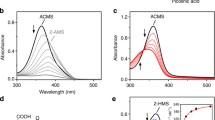Abstract
1,4-Benzoquinone reductase was purified to electrophoretic homogeneity from bovine liver, and the purified enzyme found to have a molecular mass of 29 kDa, as determined by sodium dodecyl sulfate-polyacrylamide gel electrophoresis. The enzyme exhibited pH optimum between 8.0 and 8.5. The apparentK m for 1,4-benzoquinone was 1.643 mM, and the apparent Km for NADH was 1.837 mM. Various divalent cations, such as Hg2+, Cu2+, and Zn2+, exhibited strong inhibitory effects. The enzyme activity was also strongly inhibited by quercetin, dicumarol, and benzoic acid. Incubation of the enzyme withN-bromosuccinimide and pyridoxal 5′-phosphate led to inhibitions of 100% and 99%, respectively. Accordingly, these results suggest that tryptophan and lysine residues are involved at or near the active sites of the enzyme.
Similar content being viewed by others
References
Favreau, L. V. and C. B. Pickett (1995) The rat quinone reductase antioxidant response element.J. Biol. Chem. 270:24468–24474.
Arieli, B., Y. Shahak, D. Taglicht, G. Hauska, and E. Padan (1994) Purification and characterization of sulfidequinone reductase, a novel enzyme driving anoxygenic photosynthesis inO. limnetica.J. Biol. Chem. 269: 5705–5711.
MacDonald, M. J. (1991) Quinone reductase enzyme activity in pancreatic islets.Endocrinology 129: 1370–1374.
Rao, P. V. and J. S. Zigler (1990) Extremely high levels of NADPH in guinea pig lens.Biochem. Biophys. Res. Comm. 167: 1221–1228.
Jaiswal, A. K., O. W. McBride, M. Adesnik, and D. W. Nebert (1988) Human dioxin-inducible cytosolic NAD(P)H: menadione oxidoreductase.J. Biol. Chem. 263: 13572–13578.
Hojeberg, B., K. Blomberg, S. Stenberg, and C. Lind (1981) Biospecific adsorption of hepatic DT-diaphorase on immobilized dicumarol.Arch. Biochem. Biophys. 207: 205–216.
Valli, K. and M. H. Gold (1991) Degradation of 2,4-dichlorophenol by the lignin-degrading fungusPhanerochacte chrysosporium.J. Bacteriol. 173: 345–352.
Valli, K., B. J. Brock, D. K. Joshi, and M. H. Gold (1992) Degradation of 2,4-dinitrotoluene by the lignin-degrading fungusPhanerochaete chrysosporiunt.Appl. Environ. Microh. 58: 221–228.
Valli, K., H. Wariishi, and M. H. Gold (1992) Degradation of 2,7-dichlorodibenzo-p-dioxin by the lignindegrading basidiomycetePhanerochaete chrysosporium.J. Bacteriol. 174: 2131–2137.
Zhang, Y., P. Talalay, C. Cho, and G. H. Posner (1992) A major inducer of anti-carcinogenic protective enzymes from broccoli.Proc. Natl. Acad. Sci. USA 89: 2399–2403.
Prestera, T., M. J. Prochaska, and P. Talalay (1992) Inhibition of NAD(P)H: (quinone-acceptor) oxidoreductase by Cibacron Blue and related anthraquinone dyes: A structure-activity study.Biochemistry 31: 824–833.
Gordon, G. B., H. J. Prochaska, and L. Y. Yang (1991) Induction of NAD(P)H: quinone reductase in human peripheral blood lymphocytes.Carcinogenesis 12: 2393–2396.
Bayney, R. M., M. R. Morton, L. V. Favreau, and C. B. Pickett (1989) Rat liver NAD(P)H: quinone reductase.J. Biol. Chem. 264: 21793–21797.
Ramchandani, S., M. Das, and S. K. Khanna (1994) Effect of metanil yellow, orange II and their blend on hepatic xenobiotic metabolizing enzymes in rats.Fd.Chem. Toxic. 32: 559–563.
Prestera, T., W. D. Holtzclaw, Y. Zhang, and P. Talalay (1993) Chemical molecular regulation of enzymes that detoxify carcinogens.Proc. Natl. Acad. Sci. USA 90: 2965–2969.
Delong, M. J., P. Dolan, A. B. Santamaria, and E. Bueding (1986) 1,2-Dithol-2-thione analogs: Effects on NAD(P)H: quinone reductase and glutathione levels in murine hepatoma cell.Carcinogenesis 7: 977–980.
Shaw, P. M., A. Reiss, M. Adesnik, D. W. Nebert, J. Schembri, and A. K. Jaiswal (1991) The human dioxininducible NAD(P)H: quinone oxidoreductase cDNA-encoded protein expressed in COS-1 cells is identical to diaphorase 4.Eur. J. Biochem. 195: 171–176.
Hu, T. L. (1998) Degradation of azo dye RP2B byPscudomonas luteola.Wat. Sci. Tech. 38: 299–306.
Keck, A., J. Klein, M. Kudlich, A. Stolz, H.-J. Knackmuss, and R. Mattes (1997) Reduction of azo dyes by redox mediators originating in the naphthalenesulfonic acid degradation pathway ofSphingomonas sp.Appl. Environ. Micro. 63: 3684–3690.
Heinfling, A., M. Bergbauer, and U. Szewzyk (1997) Biodegradation of azo and phthalocyanine dyes by Trametes versicolor andBjerkandera adusta.Appl. Microbiol. Biotechnol. 48: 261–266.
Rafii, F., J. D. Hall, and C. E. Cerniglia (1997) Mutagenicity of azo dyes used in foods, drugs and cosmetics before and after reduction byClostridium species from the human intestinal tract.Fd. Chem. Toxic. 35: 897–901.
Chung, K.-T. and Jr. S. E. Stevens (1992) The reduction of azo dyes by the intestinal microflora.Crit. Rev. Micro. 18: 175–190.
Kim, K. and H.-Y. Shin (2000) Reduction of azobenzene by purified bovine liver quinone reductase.J. Biochem. Mol. Biol. 33: 321–325.
Constam, D., A. Muheim, W. Zimmermann, and A. Fiechter (1991) Purification and partial characterization of an intracellular NADH: quinone oxidoreductase fromPhanerochaete chrysosporium.J. Gen. Microbiol. 137: 2209–2214.
Bradford, M. M. (1976) A rapid and sensitive method for quantitation of microgram quantities of protein utilizing the principle of protein-dye binding.Anal. Biochem. 72: 248–254.
Laemmli, U. K. (1970) Cleavage of structural proteins during the assembly of the head of bacterio phage T4.Nature 227: 680–685.
Brock, B. J., S. Rieble, and M. H. Gold (1995) Purification and characterization of a 1,4-benzoquinone reductase from the basidiomycetePhancrochaete chrysosporium.Appl. Environ. Microbiol. 61: 3076–3081.
Author information
Authors and Affiliations
Corresponding author
Rights and permissions
About this article
Cite this article
Kim, K. Characterization of 1,4-benzoquinone reductase from bovine liver. Biotechnol Bioproc E 7, 216–220 (2002). https://doi.org/10.1007/BF02932973
Received:
Accepted:
Issue Date:
DOI: https://doi.org/10.1007/BF02932973



